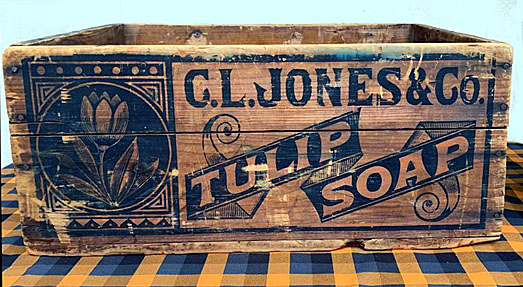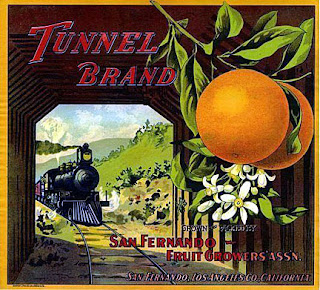 QUESTION: I like primitive antiques. Recently, while browsing a local primitive antiques show, I discovered several dealers selling old wooden fruit crates. I imagined many uses for these. But are they really collectible?
QUESTION: I like primitive antiques. Recently, while browsing a local primitive antiques show, I discovered several dealers selling old wooden fruit crates. I imagined many uses for these. But are they really collectible?
ANSWER: Today, we have all sorts of plastic containers to hold foods and other goods. But back in the good ole days—as late as the 1930s—goods came packed in wooden crates. Everyone knows the colorful ones used by the fruit industry to pack fresh fruit, but, in fact, there were as many different crates as their were products sold in general stores.
 Old wooden crates tend to evoke feelings of nostalgia—of the simple, good life. And thanks to interior decorators, they’ve become a versatile source of inspiration for creative furniture, decorative home accents, and inventive storage solutions.
Old wooden crates tend to evoke feelings of nostalgia—of the simple, good life. And thanks to interior decorators, they’ve become a versatile source of inspiration for creative furniture, decorative home accents, and inventive storage solutions.
Wooden crates go back to the time of the general store. Norman Rockwell reminded everyone of the nostalgia of those bygone days in his paintings, depicting men sitting by a warm, pot-bellied stove in the general store, smoking a pipe, reading a newspaper, with a dozing dog stretched out on the floor. In the 19th and early 20th century, especially in rural locations, the general store acted not only as a source of dry goods and food ingredients, but as a social center as well.
 Like the modern supermarket, the general store sold the essentials for living. Storekeepers displayed their goods mostly in packing crates with the lids pried off, so customers could buy the contents straight from the crate. Everyone knew what was in each box because each crate showed its contents in bold stenciling on the sides or with a brightly colored paper label.
Like the modern supermarket, the general store sold the essentials for living. Storekeepers displayed their goods mostly in packing crates with the lids pried off, so customers could buy the contents straight from the crate. Everyone knew what was in each box because each crate showed its contents in bold stenciling on the sides or with a brightly colored paper label.
Lucky customers may have been able to wrangle a packing crate from the storekeeper and turn it into a handy kitchen cabinet, bookcase, or vegetable rack. People back then reused everything, and wooden crates were no exception.
More unusual, and highly sought after, are the pieces of folk art furniture built around these boxes, making them into extremely decorative storage units for collections of anything from fishing lures to rubber stamps and other paraphernalia.
 In the early part of the 20th century these units were made by encasing wooden cheese boxes or Baker's' chocolate boxes, adding knobs and a coat of paint. Men made these utilitarian storage units to keep their woodworking or metalworking bits and pieces together in one place.
In the early part of the 20th century these units were made by encasing wooden cheese boxes or Baker's' chocolate boxes, adding knobs and a coat of paint. Men made these utilitarian storage units to keep their woodworking or metalworking bits and pieces together in one place.
In the last quarter of the 20th century these engaging folk art pieces have become highly prized, usually expensive, decorator items for a country look in the home. They now take their place in sitting rooms, dining rooms and kitchens, no longer relegated to the work room or garage.
In 1847, a stamping process became available that produced tin cans cheaply. Canneries proved to be invaluable during the Civil War and just five years after the war, 34 million cans of food were on the market throughout the United States. By 1878 canning factories proliferated all over the country, and almost every type of food could be found in a can. Many of the early cans were decorative and made in fanciful shapes to induce sales as some people were suspicious of canned foods. Canneries shipped their products in nothing other than wooden stenciled crates.
By the 1880s there were almost four million farms and about half of the world's annual yield of precious metals being panned or mined in America. More and more factories turned out packaged goods such as whiskey, soap, stoves, clocks, watches and cast-iron items like doorstops and banks, as well as pots and skillets, for the home. All these goods came packed in wooden crates.
 By the end of that decade, refrigerated railroad cars were hauling fruits and vegetables from California and Florida to New York. Seafood traveled to Chicago and freighters carried food goods around the world. For the first time, Easterners could buy Hawaiian pineapples and Maine residents could buy Florida fruit. All shipped in wooden cases with brightly colored labels. Today, these are all very collectible.
By the end of that decade, refrigerated railroad cars were hauling fruits and vegetables from California and Florida to New York. Seafood traveled to Chicago and freighters carried food goods around the world. For the first time, Easterners could buy Hawaiian pineapples and Maine residents could buy Florida fruit. All shipped in wooden cases with brightly colored labels. Today, these are all very collectible.
Soon catalogs, known as “Farmer's Bibles" and "The Nation's Wishbook," appeared. Each new issue contained even more and better things. These books changed the way America shopped in the late 19th century. The railroad depot replaced the general store, as people awaited the delivery of their large goods by freight train. One thing that didn’t change was that goods still came in wooden crates.
 Of all the old-time packaging methods, the one that has mostly been ignored by collectors is wooden crates. It's true that for many years, decorators have been taking apart early shipping crates and just using the stenciled sides or ends to create "atmosphere" both in homes and restaurants. However, it has only been in the last few years that collectors have recognized the historical significance, decorating possibilities, and value of these wooden boxes from a bygone age.
Of all the old-time packaging methods, the one that has mostly been ignored by collectors is wooden crates. It's true that for many years, decorators have been taking apart early shipping crates and just using the stenciled sides or ends to create "atmosphere" both in homes and restaurants. However, it has only been in the last few years that collectors have recognized the historical significance, decorating possibilities, and value of these wooden boxes from a bygone age.
To read more articles on antiques, please visit the Antiques Articles section of my Web site. And to stay up to the minute on antiques and collectibles, please join the over 30,000 readers by following my free online magazine, #TheAntiquesAlmanac. Learn more about art glass in the 2022 Summer Edition, with the theme "Splendor in the Glass," online now. And to read daily posts about unique objects from the past and their histories, like the #Antiques and More Collection on Facebook.




































